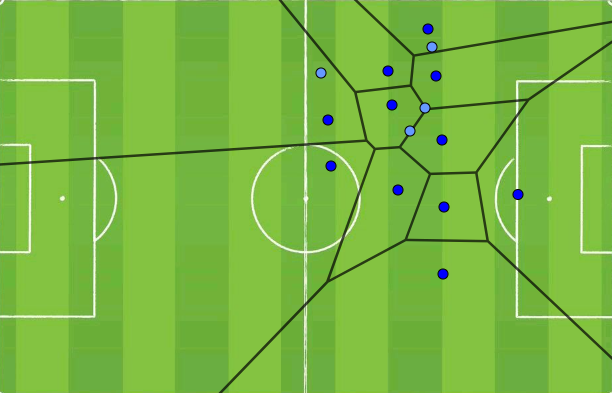Before reading this article, you can read my previous article about Manchester City’s attacking tactics to understand this article better.
As I explained in my last article about Manchester City’s attacking tactics, in set attacks, the formation changes with like a 2-3-5. Usually they try to make game from the triangle between full backs, centre midfielders and wingers. If they use these 3 players in the same passing situation, they can be effective but if the defensive midfielder, stoppers or centre forward helps them about making game and be 4 players, they can be absolutely so confusing for opponents. Now I will explain these 4 players’ positionings with a more geometrical way.
These 4 players don’t have a regular role but nearly in all situations, automatically, there is a passer who will make the game in the moment situation, there is a pass receiver who will take the ball from passer and there are two players who will distract the opponent’s players and help to passer and pass receiver to complete the passing connection. These two players could be pass stations too but their first role is distracting the opponent’s players.
And also all these 4 players take position geometrically well in Voronoi diagram. With Voronoi diagram, you can see every players’ spaces. And Manchester City’s players use Voronoi diagram perfectly and confuse the opponent. I explain now all these things.
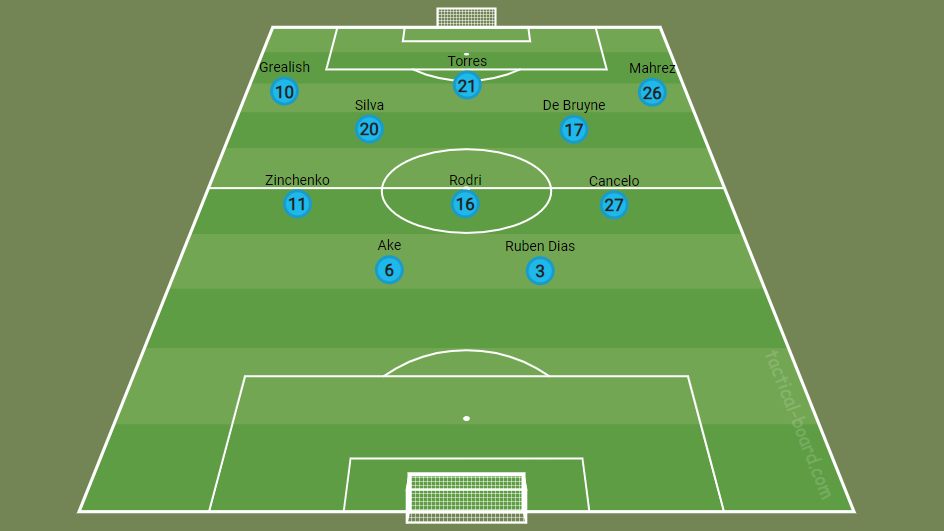
In this situation, Manchester City are trying to make game against Chelsea’s 5-3-2. Laporte has the ball. De Bruyne is in wing between the opponent’s forward and midfield lines and Grealish is matching with the opponent’s right stopper. The opponent’s centre stopper is matching with Foden. And the opponent’s centre midfielder is taking position to cut the connection between Laporte and players who can be dangerous for Chelsea if Laporte can pass directly.
Then De Bruyne started to move to forward. And Grealish started to run to half-space diagonal. With Grealish’s movement, firstly the opponent’s right stopper followed Grealish few meters. And also the opponent’s centre stopper closed to Grealish little bit too. But then right stopper saw De Bruyne is closing to forward and let Grealish’s marking to centre stopper and came back to his position. The opponent’s right wing back saw De Bruyne’s movement too and he closed to defense line too. And also because De Bruyne and Grealish moved from left, the opponent’s centre midfielder closed to wing a little bit because De Bruyne and Grealish distracted him.
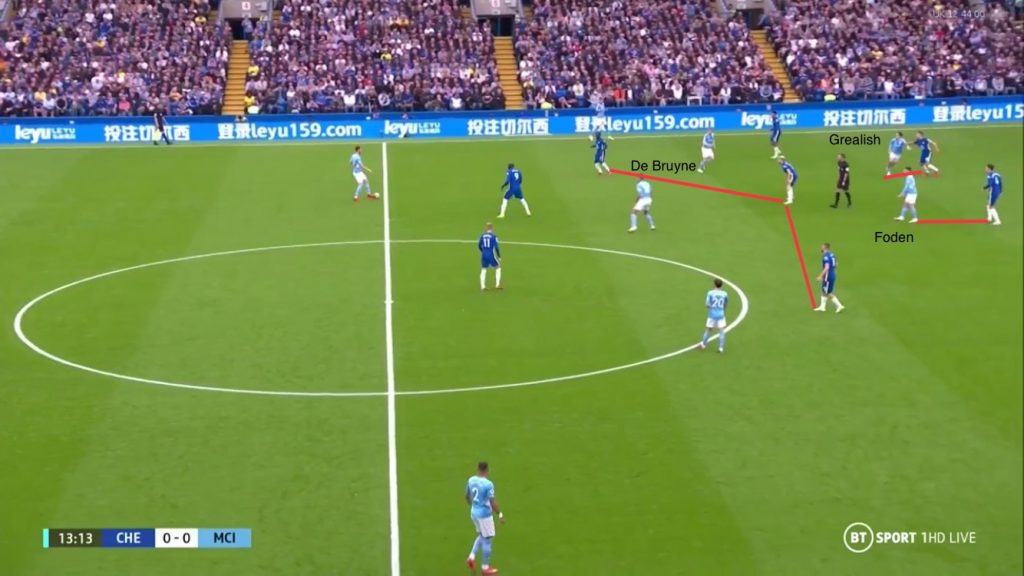
As a result of De Bruyne’s and Grealish’s movements, now the opponent’s centre midfielder cared about covering wing a little bit more. Now both right wing back and right stopper focused on to covering De Bruyne and both right stopper and centre stopper focused on to covering Grealish too. Both De Bruyne and Grealish took positions in between defense players. So 2 players pulled 3 defenders.
Now Foden was free and Laporte could pass to him. The opponent’s centre midfielder couldn’t cut the connection between Foden and Laporte because he focused on to wing and shifted to wing little bit. The opponent’s centre stopper was marking Foden but because he focused on to marking Grealish, he can’t mark Foden anymore. So Laporte could pass to Foden comfortably and they could improve the attack.
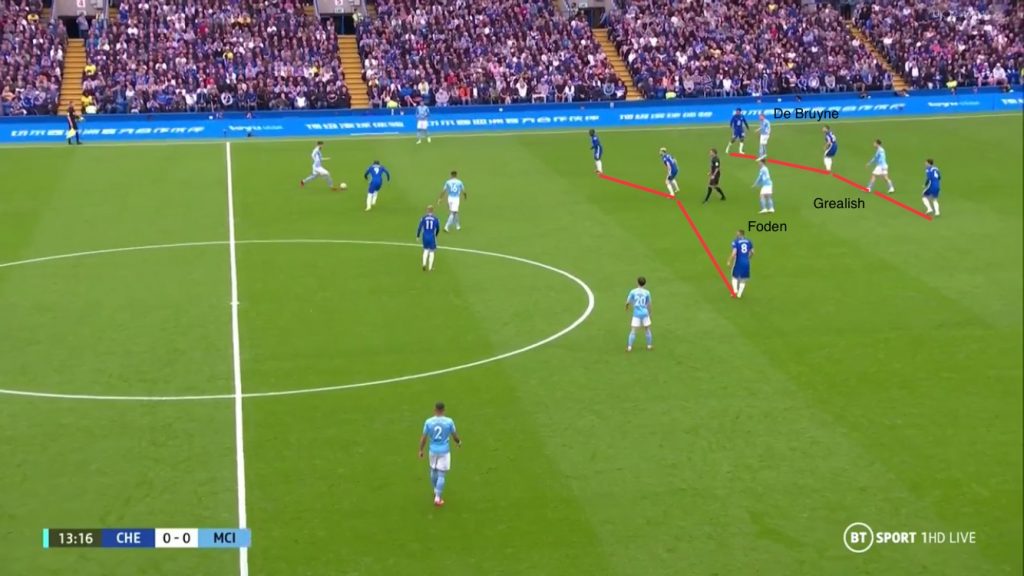
Now let’s look at this situation with Voronoi diagram. In this diagram, you can see Chelsea’s players’ space sharing for the situation. And you can see Manchester City’s 4 players’ positionings in these spaces who directly effect this attack: Laporte, De Bruyne, Grealish and Foden.
These spaces’ meanings for Chelsea players is who has to cover a Manchester City’s player when. For example, it’s clear the opponent’s right centre forward has to cover Laporte because now, Laporte is in his covering space. But covering Grealish, De Bruyne or Foden is not simple like covering Laporte.
Because if a Manchester City player takes position in Chelsea’s Voronoi diagrams’ lines, like Grealish, De Bruyne and Foden do in this situation, there is a sharing spaces problem for the defending team. Because this time it’s not clear who has to cover the attacker who takes position in the line.
In our situation, as you see, Grealish, De Bruyne and Foden takes position in lines. In De Bruyne’s situation, both the opponent’s right wing back and right stopper has to be careful about De Bruyne because he nearly takes position in the line. So covering De Bruyne is not one of their missions but also both of their missions. So it is a confusing thing for the opponent.
Grealish’s situation is similar like De Bruyne’s, both the opponent’s right stopper and centre stopper have to be careful about covering Grealish. So right stopper has to be careful about covering both De Bruyne and Grealish at the same time.
Also, to cover De Bruyne or Grealish, if one of these defenders close to one of De Bruyne or Grealish, this player has to cover too much distance because both De Bruyne and Grealish take position at their spaces horizontally furthest points. And it would be a big waste of time.
Foden’s positioning is even better. Both the opponent’s centre midfielder and centre stopper has to be careful about him. They have a problem because when De Bruyne and Grealish moved from left, centre midfielder focused on to De Bruyne and Grealish little bit more. So he shifted to wing a little bit and it means, he can’t focus on to Foden. Also because Grealish pulled the opponent’s centre stopper to himself, centre stopper can’t close to Foden. And if he decides to close to Foden, this time, because the distance between him and Foden is diagonal, he has to cover too much distance. Because the distance between Foden and centre stopper is diagonal, not straight and diagonal distance is longer than horizontal or vertical distance. So if centre stopper would want to close to Grealish, he would cover less distance because the distance between Grealish and centre stopper is horizontal, not diagonal. You can find this answer with Trigonometry.
And also because centre stopper has to cover too much distance to cover Foden and also Grealish takes position between centre stopper and right stopper, if he closes to Foden, Grealish can escape from the opponent’s defense line’s back easily. Because not the opponent’s any player would mark him closely and now also the distance between centre stopper and right stopper is too much. So he can escape from more space and because of that, right stopper’s catching Grealish probability becomes less too.
In this situation, Foden’s positioning is better than Grealish because the connection between Foden and Laporte is diagonal. The connection between Grealish and Laporte is straight. So it means, the opponent’s centre midfielder can cut the connection between Grealish and Laporte comfortably because in straight connections, because the ball’s direction doesn’t change horizontally, if the opponent’s player takes position in a regular way, even if he doesn’t want to cut the connection, he can cut the connection by keeping to take position in a regular way without an extra effort because the ball’s horizontal direction won’t change. So he just has to focus on taking position in the same straight way. He doesn’t have to focus on moving to right or left. He just has to focus on moving to forward or behind.
But in Foden’s positioning, the opponent’s centre midfielder can’t cut the connection between Laporte and Foden. Because the ball will go to Foden from Laporte from a diagonal way. So it means, the ball will change direction at the same time horizontally and vertically. So to cover Foden, the opponent’s centre midfielder has to focus on about moving diagonal and it means, he has to accord his position to right or left and also to forward or behind at the same time. And it is a more confusing thing for the opponent than the previous situation.
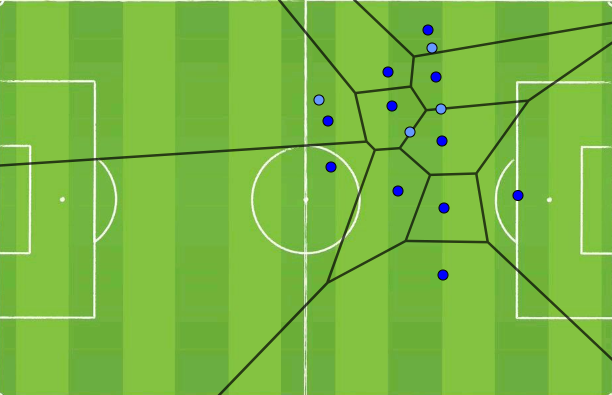
And also we can say that, in this situation, if Grealish would take position in little bit behind in centre stopper’s, right stopper’s and centre midfielder’s spaces’ intersection point and also if the connection between Laporte and Grealish would be diagonal, this positioning would be literally perfect.
If Laporte took position a little bit closer to wing, he could pass to Grealish diagonally from between the opponent’s centre and right centre midfielder’s. And when Grealish took the ball, any of the opponent’s players couldn’t press to Grealish quickly. The opponent’s right and centre stoppers couldn’t cover Grealish quickly because to cover Grealish, they had to cover distance diagonally and it would be an extra waste of time for them.
The opponent’s centre midfielder couldn’t cover Grealish quickly because when Grealish took the ball, he remained at centre midfielder’s behind. So to cover Grealish, centre midfielder had to turn around. And it would be an extra waste of time for him.
And if they don’t have a regular defending positioning for situations like this, each of these 3 players could let marking Grealish to other 2 players. So it would confuse the opponent so much.
